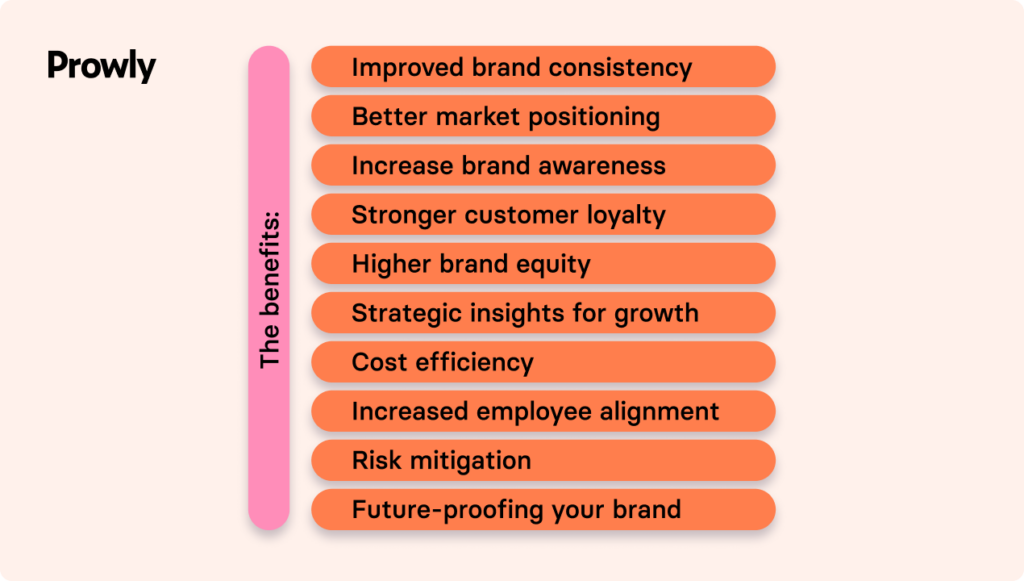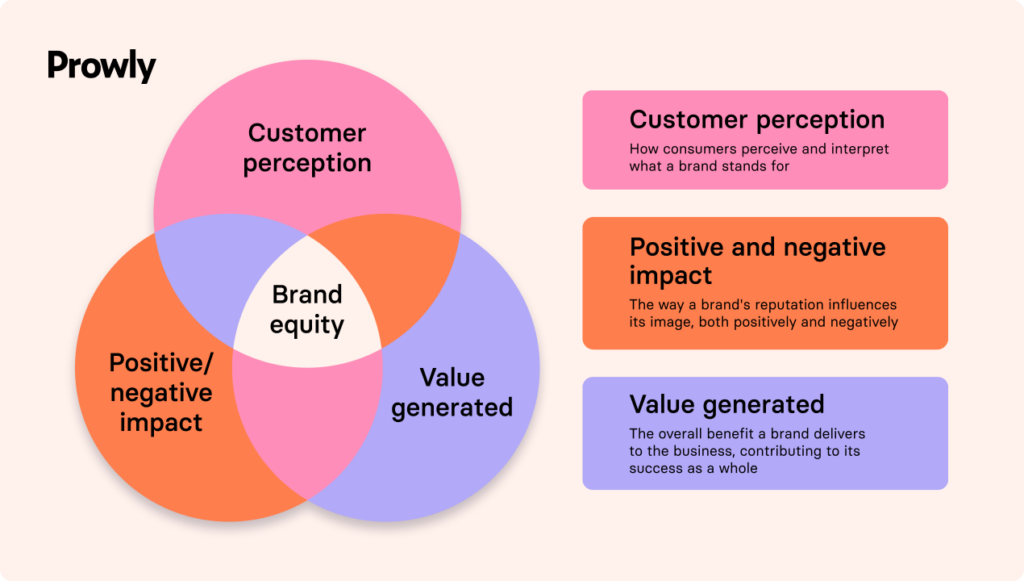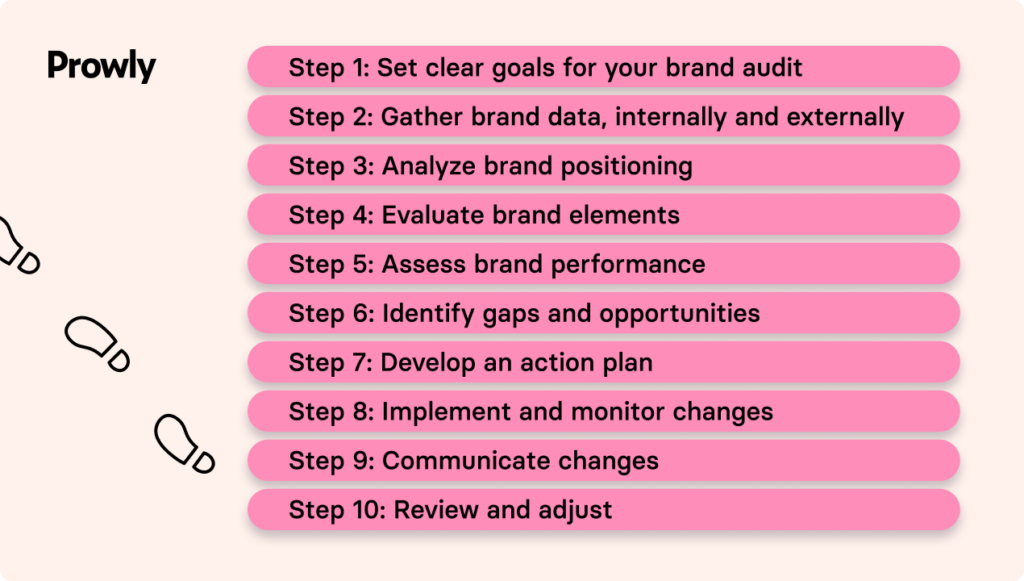A brand audit is a health check for your brand: a way to determine how people perceive you and where you stand against your competitors.
You can use a brand audit to benchmark your brand's performance, determine your brand equity and main brand elements, and in general, find out what people think of you.
This may sound like a lot of work, but in reality, it's much easier to conduct a brand audit than you may think.
Today, we'll show you what the brand audit process looks like, why you should go through it, and a step-by-step guide on how to do a brand audit for yourself.
Start your brand audit process today with a free trial of Prowly
Try Prowly completely free for 7 days in a platform that has everything you need for PR.
- All-in-one software: Get everything you need in one tool for PR, incl. media database, outreach, reporting, and more
- Transparent Pricing: Plans start at $258/month
- Comprehensive Monitoring: Track the web, social media, print, and broadcast mentions
What is a brand audit?
A brand audit is a comprehensive analysis of a brand's current market position. A thorough brand audit includes an assessment of brand identity, messaging, customer perception and its overall effectiveness in meeting business objectives.
Your typical brand audit template is going to include the following elements:
- Brand identity
- Brand messaging
- Customer perception
- Market positioning
- Brand performance
However, there is more than one brand audit framework and you should choose the steps that best align with your own brand audit goals. But more on that in a second.
9 benefits of the comprehensive brand audit process
To conduct a brand audit may seem like a lot of work and you may be wondering if it is worth the effort. Here are some of the major benefits of running a successful brand audit.

Lets break them down. 👇
#1 Improved brand consistency
A brand audit ensures that all of your messaging is consistent across different channels, be it social media, your website or print. Cohesive messaging prevents your customers from getting confused over what you're trying to convey as a brand.
On top of that, you can achieve visual cohesion by ensuring your design is consistent across platforms.
#2 Better market positioning
When you conduct a brand audit, you can learn the true differentiators between you and the rest of your competitors. In a crowded market, many companies tend to have similar positioning, which dilutes your chances of standing out.
A thorough brand audit process reveals what makes your company truly unique so you can embed it into your marketing and sales messaging.
#3 Increase brand awareness
A successful brand audit will reveal new opportunities for spreading the word about your brand. A good brand audit example will show you that perhaps your presence on Instagram is stellar, but you're leaving money on the table by not being present on TikTok.
Stronger customer loyalty
When you understand how customers perceive your brand, you’ll discover gaps between your brand promise and the actual customer experience. You'll find out exactly what to fix to deliver a stronger emotional connection with your brand.
#4 Higher brand equity
A comprehensive brand audit shows you how your brand performs in terms of reputation, recognition and value. When you improve all of these aspects, you can benefit from higher brand equity and, as a result, improved customer trust, premium pricing opportunities, and better overall business value.

#5 Strategic insights for growth
You'll learn about your brand performance, customer preferences and market trends. Instead of tiptoeing in the dark, you'll know exactly which markets, target audiences, verticals, and customer segments present the best opportunities for growing your business.
#6 Cost efficiency
With a comprehensive brand audit, you'll find potential inefficiencies. For example, using the wrong brand voice to target a customer segment that is highly valuable for your bottom line.
In turn, this streamlines your marketing and branding activities and lets you find out where to best spend your advertising dollars. For example, you may be spending thousands on display ads while investing in TikTok influencers who can create UGC campaigns might be better for your brand's identity.
#7 Increased employee alignment
A successful brand audit reveals your core mission, vision, values and messaging. You can then communicate these to your employees, which ensures that everyone is on the same page. Even more importantly, it helps them instil these values in their everyday work.
#8 Risk mitigation
Whether you use brand audit services or do the work yourself, a brand audit checklist will reveal all the potential risks your brand may be facing. Brand perception, competitive changes, shifts in market trends... Conducting a brand audit can help spot all of them.
#9 Future-proofing your brand
While no one has a crystal ball, 🔮 a brand identity audit can help protect you against changes in the future, such as in market trends and consumer behaviour. By studying your brand today, you'll learn what (not) to do to avoid brand catastrophes in the months and years to come.
P.S. Read this article on brand protection to learn the best tips and strategies.
How to do a successful brand audit, step by step
How does one conduct a brand audit in the first place? Are there brand audit tools that you can use? Which brand audit format should you follow?
Here is everything you ever wanted to know in a simple, step-by-step guide for conducting an audit on your brand's performance.

Let's expand on these points and develop an effective brand audit. 👇
Step 1: Set clear goals for your brand audit
Doing a brand audit is hardly a five-minute job and requires tedious preparation and execution from multiple members of your team. Before diving into it, determine what you want to achieve, because this will impact the tools, processes and people you use for the job.
For example, you may want to improve your:
- brand awareness
- customer perception
- overall market positioning
- or something entirely different
Let's say you want to increase brand awareness and recognition in the younger population. The goal of your brand audit will be to determine how your brand resonates with that target audience.
Step 2: Gather brand data, internally and externally
To fully understand your brand's perception, both within your company and in the broader market, it's essential to gather data from internal and external sources.
By combining insights from both areas, you’ll get a comprehensive view of how your brand is seen and how it aligns with your company’s mission, vision, and values.
Internal data collection
Start by evaluating how your employees perceive your brand. This can be achieved through several methods:
- Employee surveys and interviews: Use these to gauge whether your internal mission and values are aligned with the brand image you're portraying externally.
- Sales and customer service feedback: Collect insights from customer-facing teams to identify common pain points and brand perceptions they encounter.
- Internal performance metrics: Metrics like staff turnover rates, brand compliance, and the effectiveness of internal branding initiatives can reveal how well your brand is integrated internally.
- One-on-one interviews: This qualitative approach allows you to dive deeper into employees’ feelings about the company’s brand and culture.
External data collection
Once you have a clear understanding of your internal brand perception, it’s time to evaluate how your brand is seen by customers, partners, and the broader market. Here’s how to gather external data:
- Customer surveys: Use email, website pop-ups, or SMS to collect qualitative and quantitative feedback on how your brand is perceived.
- Social media analysis: Track brand mentions and analyze the sentiment behind them. Tools like Prowly’s media monitoring can help by tracking online mentions across various platforms and using AI-powered filters to highlight the most relevant. This gives you a clearer, real-time view of how the public perceives your brand.

- Market research and competitor analysis: Collect data on your competitors' performance, market presence, and unique selling propositions. This will help you position your brand effectively in comparison.
- Website and SEO analysis: Assess competitors’ organic traffic, keyword rankings, and SEO strategies to understand their digital presence and how you can improve yours.
- Third-party reviews and ratings: Websites like Google Reviews, Yelp, and TrustPilot can offer valuable insights into how customers rate and perceive your brand compared to others.
By collecting and analyzing both internal and external feedback while leveraging tools like Prowly for comprehensive media monitoring, you’ll be able to form a complete picture of your brand’s perception. These insights are crucial for making informed decisions about your branding strategy and ensuring your company’s image is aligned with your values, both internally and externally.
Try Prowly's media monitoring free for 7 days
Start tracking your brand and keywords for free (no credit card required) in Prowly.
- Comprehensive monitoring: Track the web and social media mentions.
- Transparent pricing: Plans start at $258/month
- All-in-one platform: Get everything you need in one tool for PR, incl. media database, outreach, reporting, and more
Step 3: Analyze brand positioning
At this stage, determine how your brand stands against the competition and how your target audience perceives you. This key step includes several smaller tasks that are vital to the brand audit:
1️⃣ Define your Unique Selling Proposition (USP)
Your USP is the core of your brand identity—it’s what sets you apart from the competition. Ask yourself: Is your USP still accurate, relevant, and effectively communicated?For instance, Ryanair’s USP is offering the cheapest flights without extra frills.
2️⃣ Evaluate your market positioning and competitor landscape
This stage is about finding your market share, establishing brand awareness, and learning how customers perceive you. Use tools like Prowly for social media monitoring to analyze not just your brand’s performance, but also that of your competitors.
3️⃣ Conduct a competitor analysis
As part of your competitor analysis, identify your main competitors and their positioning compared to yours. Then evaluate their strengths and weaknesses and analyze their branding strategies, customer engagement, and product offerings.
4️⃣ Reality check
Once you've gathered enough data from your customers, it's time for a reality check: does the way customers perceive you align with how you want to be perceived?
Step 4: Evaluate brand elements
These include the visual, verbal, and emotional components that shape your brand’s identity. You want to ensure that all of these elements on their own (and combined) accurately represent your brand's image. From your logo to the copy on your ads, everything needs to be looked at.
The visual elements of your brand include the following:
👉 logo
👉 color scheme
👉 typography
👉 imagery and graphics
Evaluate them all and ensure that they paint a picture that reflects your brand's values and intended goals.
Your verbal identity encompasses:
👉 brand voice
👉 messaging
👉 tagline
The copy you use should build a connection with your target audience, convey your values, and showcase your personality.
The emotional impact part of your brand includes the following elements:
👉 emotional appeal
👉 customer experience
In short, how you appeal to customers' emotions and how they feel when spending money with you and interacting with your representatives.
Once all of this is done, make sure there is consistency across different touchpoints in your communication.
Step 5: Assess brand performance
Now comes the difficult part: looking at cold, hard facts and assessing your brand performance through a variety of metrics.
First, consider the key performance metrics (KPIs) for brand performance. Some great starting points are:
- brand awareness (surveys, social media mentions, website traffic, search engine data)
- customer loyalty and retention (repeat purchase rates, customer lifetime value, subscription renewal rates)
- market share
- brand equity
Once this is done, perform customer feedback and sentiment analysis.

With tools such as Prowly, this is an easy task.
👉 Simply choose a set of keywords and the types of sources you want to look at.
👉 Once mentions start coming in (from websites, social media platforms, review websites, etc.), Prowly will gather and determine the sentiment of each mention. At a glance, you'll be able to see how your customers perceive you.
Last but not least is sales and financial performance. This is where you see how brand awareness and engagement are translated to new revenue and achieving business objectives.
Step 6: Identify gaps and opportunities
With all the information in one place, you can take the next steps and find out what you can do to stand out.
1️⃣ Analyze brand perception vs. identity
Start by comparing your brand’s intended identity with how it’s perceived by your audience.

Any discrepancies highlight gaps that you should address. For example, if you want to be considered customer-centric, but feedback indicates poor service, you can invest in better customer support or customer success.
2️⃣ Spot strategic weaknesses
Conduct a SWOT analysis to identify internal weaknesses and external threats. Look at underperforming marketing channels or inconsistent messaging as potential areas for improvement.
3️⃣ Explore market trends
Keep an eye on emerging trends and consumer shifts that present new opportunities. For instance, if sustainability is becoming more important in your industry and your brand hasn’t focused on this, it can be an opportunity to realign.
4️⃣ Address customer needs
Gather feedback to identify unmet customer needs or pain points. If customers consistently request a feature your product lacks, this is a gap that presents an opportunity for innovation.
5️⃣ Evaluate market penetration
Assess how well your brand is known in different markets. Gaps in awareness or presence, especially in untapped regions, offer opportunities for growth.
6️⃣ Prioritize and plan
Finally, prioritize these gaps and opportunities based on their potential impact and ease of implementation. Focus on those that offer the highest return on investment to strategically enhance your brand quickly and cheaply.
Step 7: Develop an action plan
After identifying gaps and opportunities, create a structured action plan to guide you in addressing key issues and finding opportunities for your brand’s growth.
First, prioritize your objectives based on their potential impact and feasibility. Focus on actions that align closely with your business goals and offer the highest return on investment. For instance, if improving customer engagement is a top priority, this should be at the forefront of your plan.
Next, set SMART goals—goals that are Specific, Measurable, Achievable, Relevant, and Time-bound.
💡 For example, you might aim to increase social media engagement by 20% over the next six months by enhancing content quality and frequency.
Once your goals are clear, define the action steps needed to achieve them. Break down each objective into smaller, manageable tasks, detailing the processes required.
Ensure you include necessary resources such as budget, tools, and personnel. For instance:
- Conduct audience research to tailor content.
- Develop a content calendar with engaging posts.
- Allocate budget for sponsored content and collaborations.
It’s important to assign responsibilities to specific team members or departments. This ensures accountability and clarity in roles. For example, your marketing team can be responsible for creating and scheduling content, while the analytics team monitors engagement metrics.
Establishing timelines is crucial. Set clear deadlines for each action step and use project management tools to track progress. For example, complete audience research by Month 1, and roll out the new content strategy starting Month 2.
Finally, determine evaluation metrics to measure success. Monitor progress regularly and adjust strategies as needed. Implement the plan diligently and review outcomes periodically, adapting based on feedback and performance data to ensure continuous improvement.
Step 8: Implement and monitor changes
With your action plan in place, it’s time to put it... well into action! The implementation phase is where strategies turn into real-world results, but success depends on careful execution and ongoing monitoring.
1️⃣ Start by rolling out the plan according to the established timelines.
Ensure that all team members are aligned and understand their responsibilities. For instance, if the goal is to enhance your website’s user experience, the design team should start with the necessary updates while the marketing team prepares to promote the changes.
2️⃣ As you implement each step, maintain open communication across teams.
Regular check-ins and updates help ensure that everyone stays on track and any issues are addressed promptly. It’s essential to foster a collaborative environment where feedback is encouraged, as this can lead to improvements in the process.
3️⃣ Monitor progress closely using the KPIs and metrics you established during the planning phase.
This could include tracking metrics like customer engagement, website traffic, or sales figures, depending on the goals. For example, if your objective is to increase social media engagement, monitor likes, shares, comments, and follower growth on a weekly or monthly basis.
4️⃣ Adjust your strategy as needed based on the data you collect.
If something isn’t working as expected, be flexible and willing to pivot. For instance, if a new marketing campaign isn’t generating the desired results, analyze the active data to identify what’s not resonating and make the necessary adjustments.
5️⃣ Finally, document your progress and outcomes.
Keeping detailed records allows you to learn from successes and challenges, which will be invaluable for future initiatives. Regularly reviewing these insights ensures that your brand will continue to evolve and improve.

💡 Prowly can help you monitor your brand and create reports that showcase the value of your work—all within one app.
Step 9: Communicate changes
Effectively communicating changes is a crucial step in ensuring that both your internal team and external audiences are aware of and aligned with the new direction your brand is taking. Transparent communication helps build trust and foster smooth transitions.
Start by informing your internal team about the changes. Hold meetings or send out detailed memos to ensure that every department understands the updates and how they impact their roles. This internal communication should highlight the reasons behind the changes, the expected outcomes, and how the team’s efforts contribute to the brand’s success.
Training sessions may be necessary if the changes involve new processes or tools. For example, if you’re rolling out a new customer relationship management (CRM) system, ensure that all relevant staff are adequately trained to use it efficiently.
Once your team is aligned, communicate the changes to your external audience. This includes customers, partners, and other stakeholders. Use a multi-channel approach—such as email newsletters, social media announcements, and press releases—to reach your audience effectively. Be clear about what is changing, why it’s happening, and how it benefits them.
For instance, if you’re launching a new product feature, highlight how it enhances user experience and meets customer needs. Transparency is key, so address any potential concerns and provide a platform for feedback.
Leverage storytelling in your communication to make the changes more relatable and engaging. Share the journey behind the changes, including the challenges you’ve overcome and the goals you aim to achieve.
Finally, monitor the response to your communication efforts. Track metrics like email open rates, social media engagement, and customer inquiries to gauge how well your message is being received. Adjust your communication strategy if necessary to ensure clarity and effectiveness.
Step 10: Review and adjust
The final step in your brand audit process is to continuously review and adjust your strategies. This ongoing cycle of evaluation ensures that your brand remains dynamic, responsive, and aligned with market demands and business goals.
Start by scheduling regular reviews of your brand’s performance.
Depending on the nature of your initiatives, this could be monthly, quarterly or annually. The key is to establish a routine that allows you to consistently monitor progress and make informed decisions.
Analyze the data you’ve collected from your implementation and monitoring efforts.
Compare these results against the KPIs and goals you set earlier. For example, if your goal was to increase customer engagement, look at metrics like website traffic, social media interactions, and customer feedback to assess how well you’ve achieved this.
Identify areas of success as well as those that need improvement.
Celebrate and document the successes, as they can provide valuable insights and motivation for your team. For areas where the results fell short, dig deeper to understand why. Was it an issue with execution, external factors, or perhaps the strategy itself?
Adjust your strategies based on these insights.
Flexibility is crucial—don’t hesitate to pivot or refine your approach to better align with your objectives. For instance, if a particular marketing channel isn’t delivering the expected ROI, consider reallocating resources to more effective channels or to try out a new approach.
Engage your team in the review process to gather diverse perspectives and ideas.
This collaborative approach often leads to more innovative solutions and a stronger commitment to the brand’s goals.
Finally, document your findings and provide updates to ensure that the what you've learned from this cycle inform future strategies. This not only helps in tracking progress but also in continuously evolving your brand to stay competitive and relevant.
Try Prowly's media monitoring free for 7 days
Start tracking your brand and keywords for free (no credit card required) in Prowly.
- Comprehensive monitoring: Track the web and social media mentions.
- Transparent pricing: Plans start at $258/month
- All-in-one platform: Get everything you need in one tool for PR, incl. media database, outreach, reporting, and more
Conclusion
Doing a brand audit takes considerable time and money, which is why companies often outsource it to third parties or put it off for later, often until it's too late. As complex as it may sound, a good brand audit can not only show your competitors' weaknesses but also highlight the exact moves you should make to get better results from your marketing and sales efforts.
With Prowly, you can automate a huge part of your research to better understand how your audience feels about you and your top competition. With our media monitoring and social media listening features, you'll always know how others perceive your brand.
Grab your free trial of Prowly and kickstart your brand audit today!

